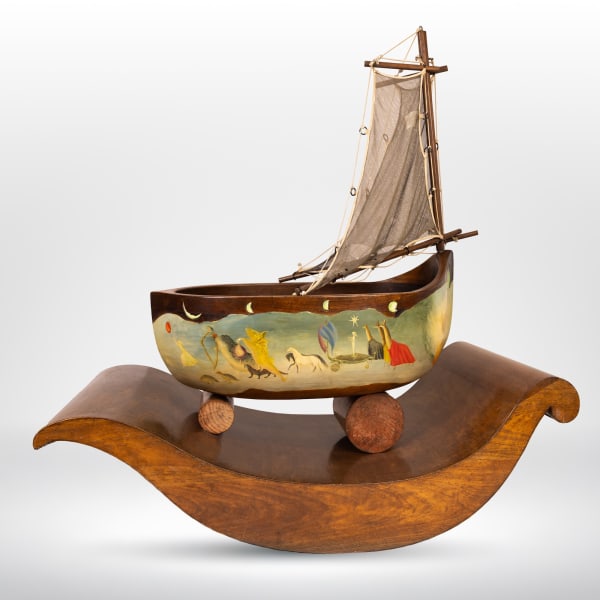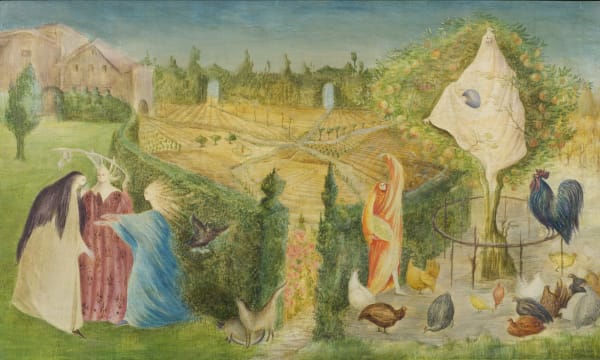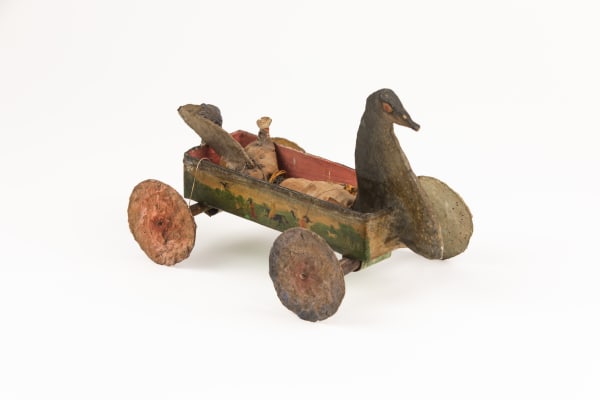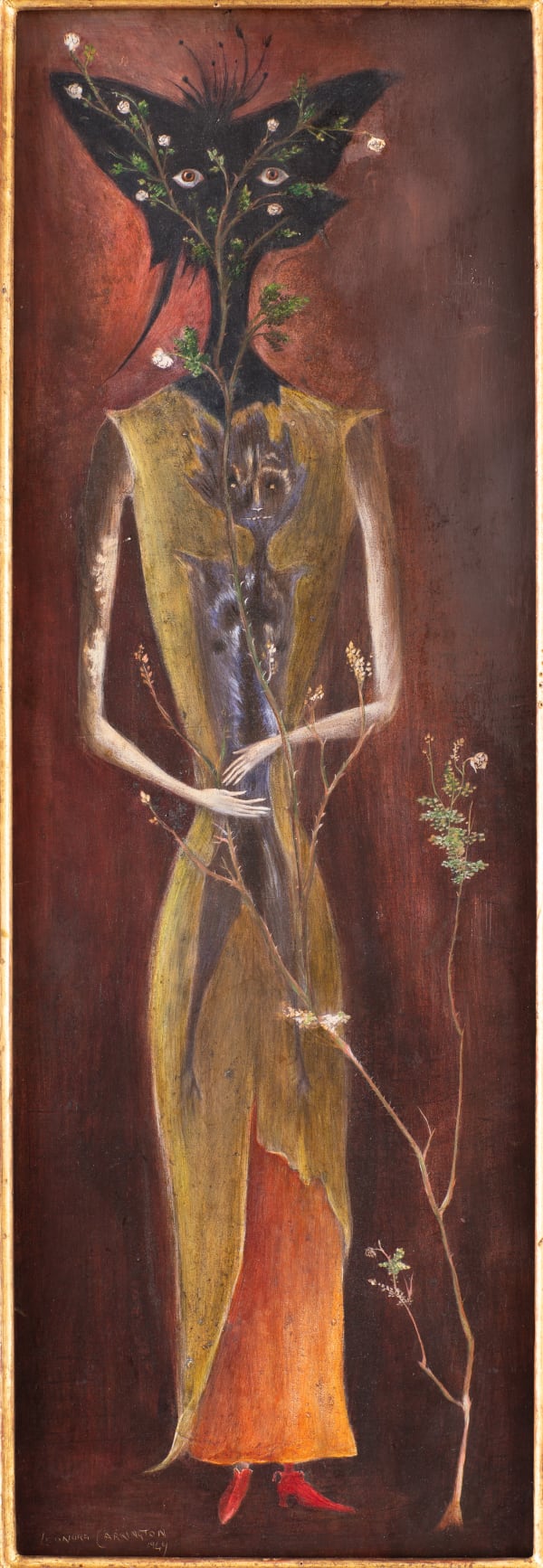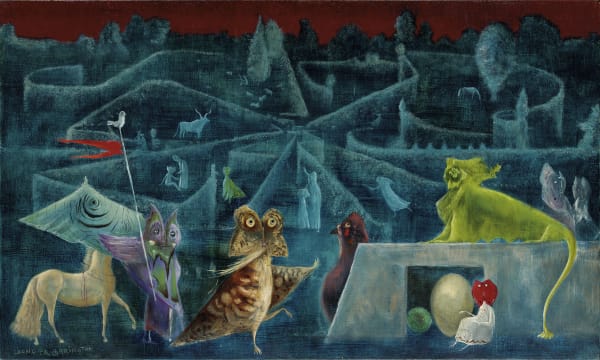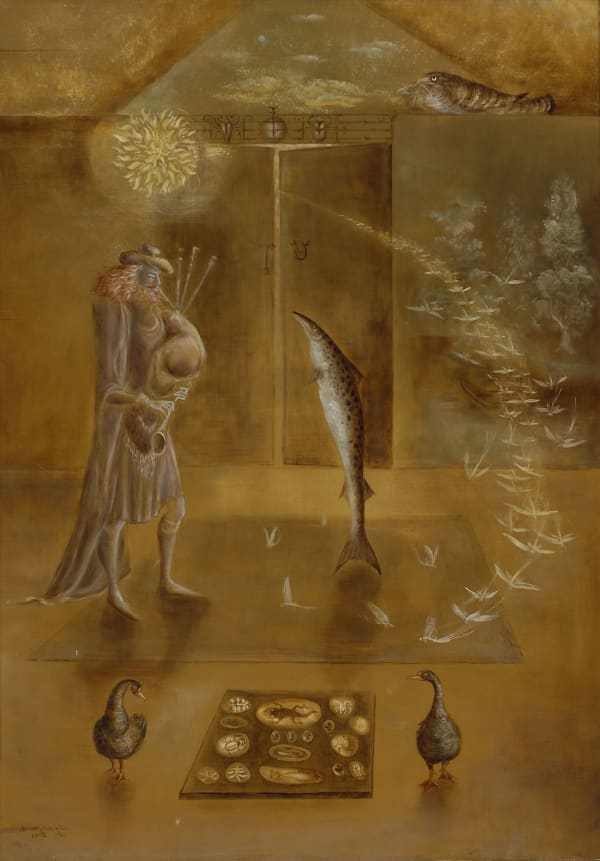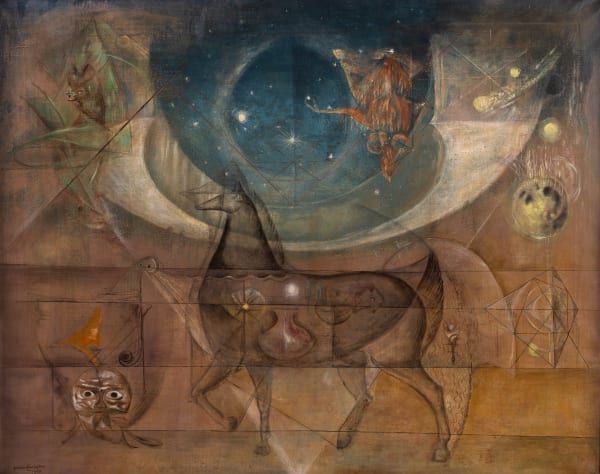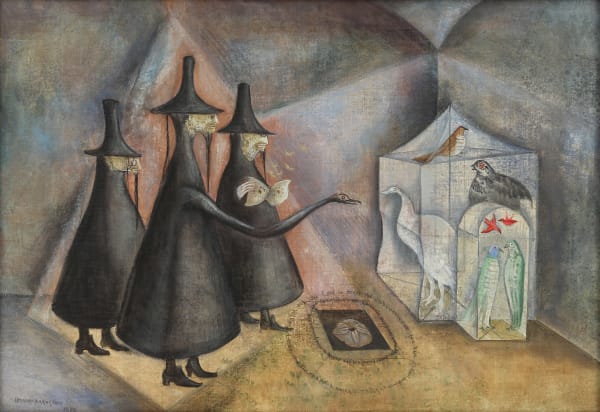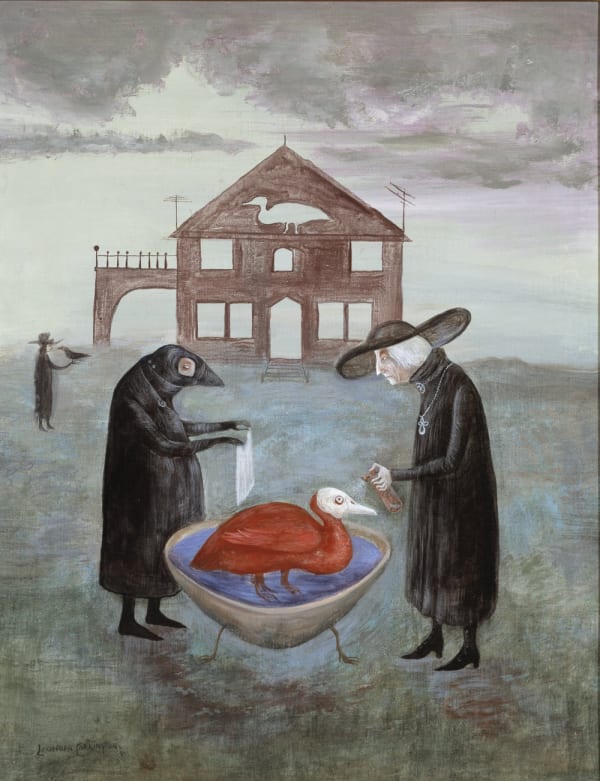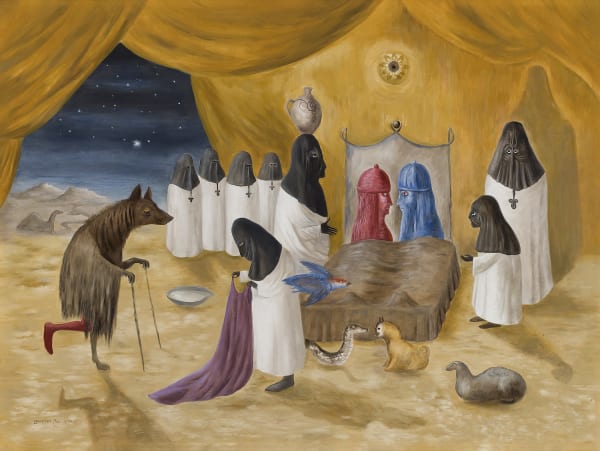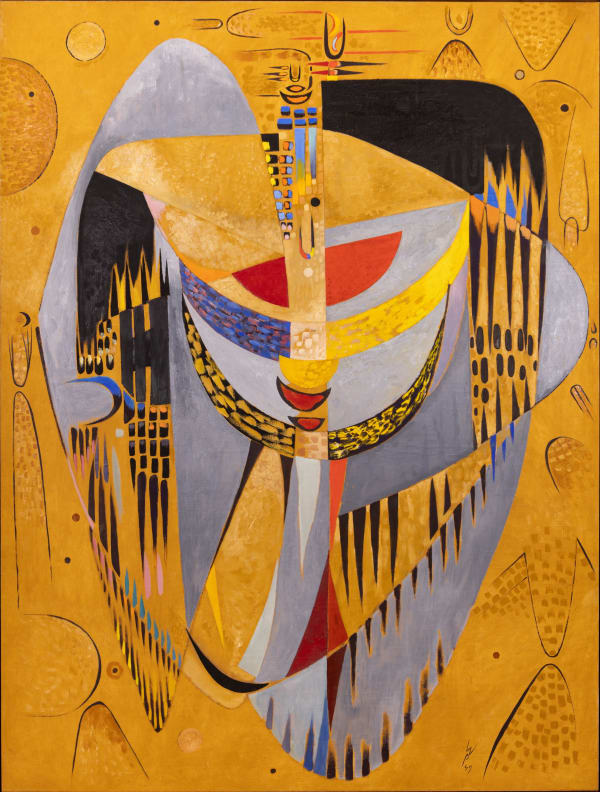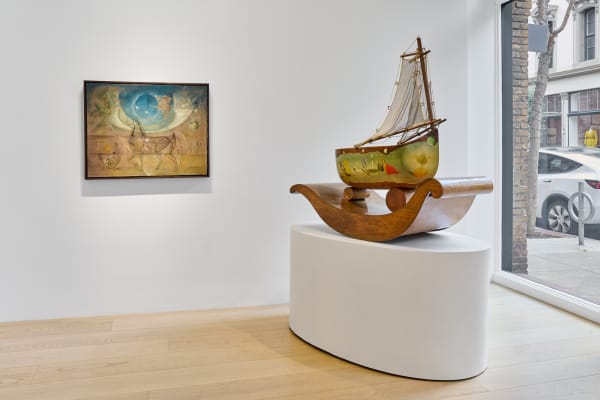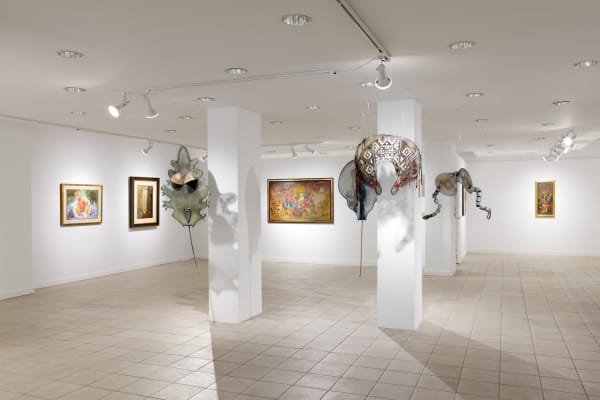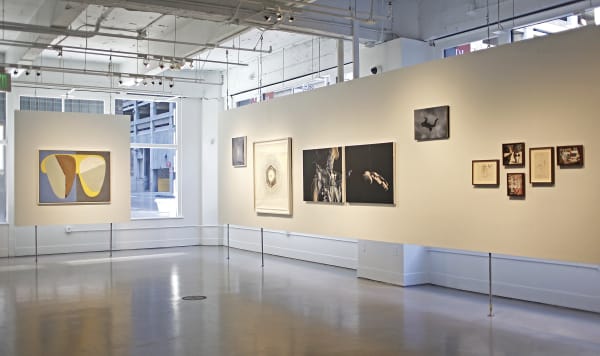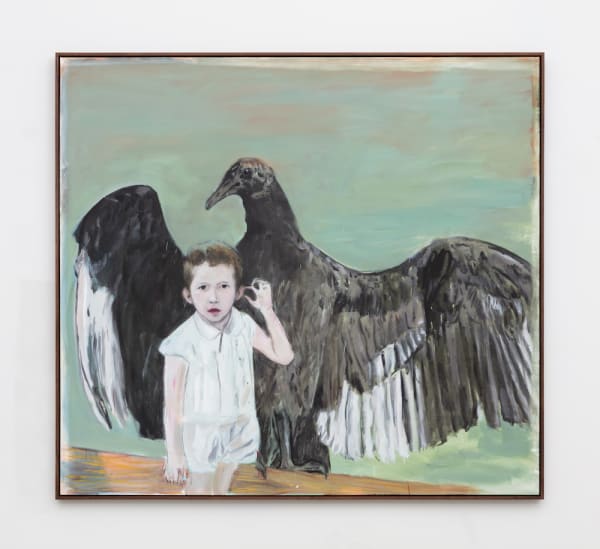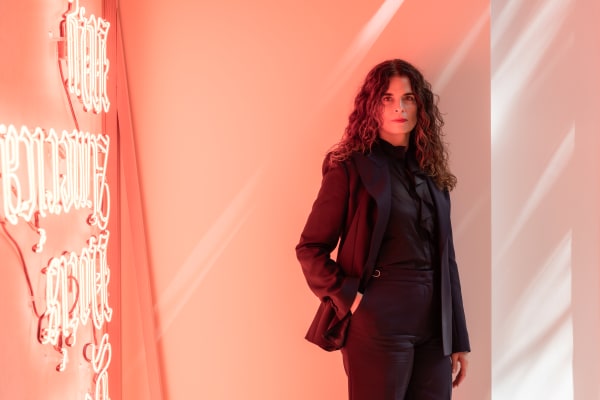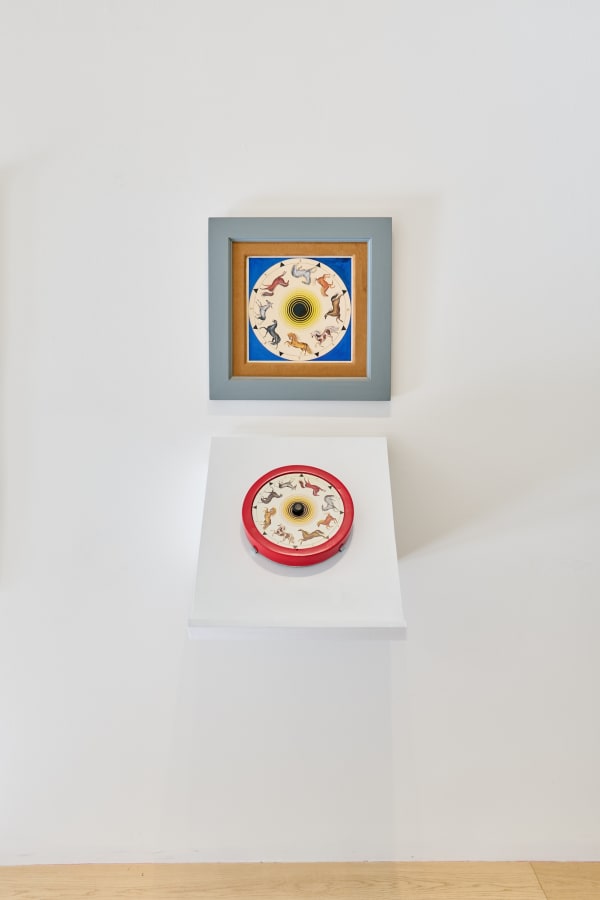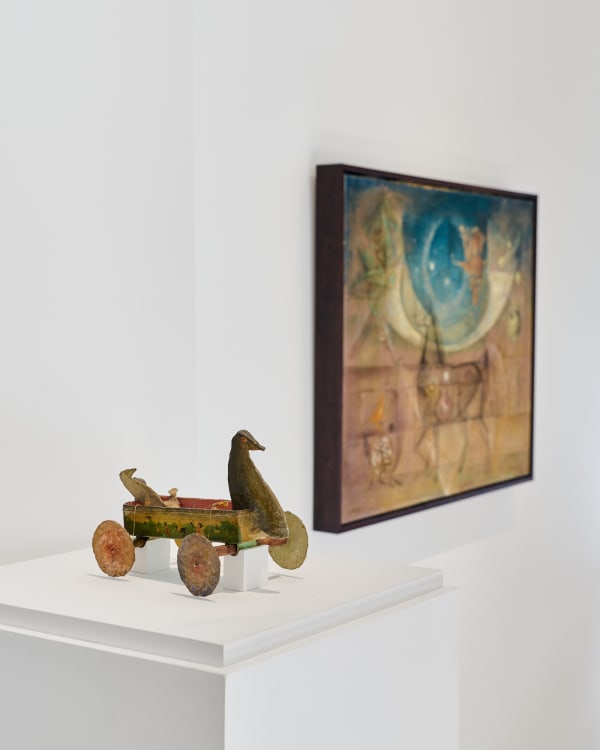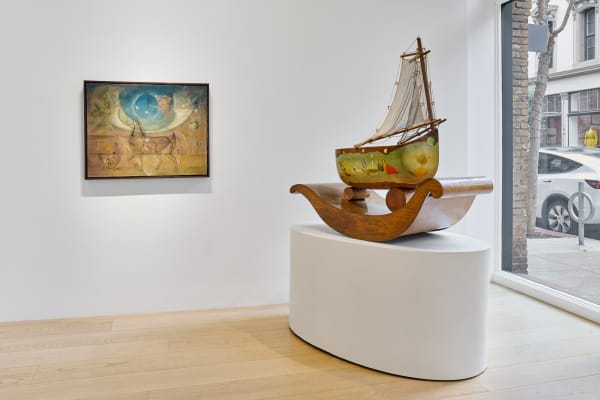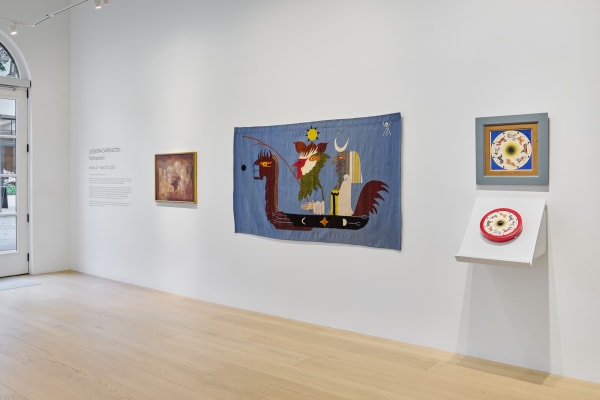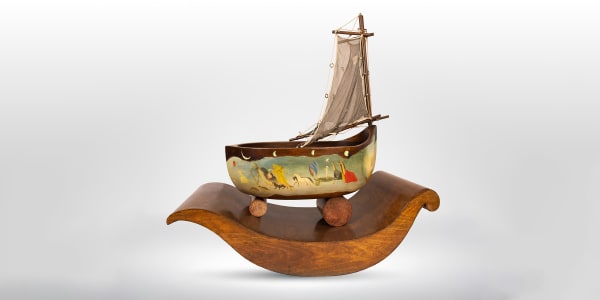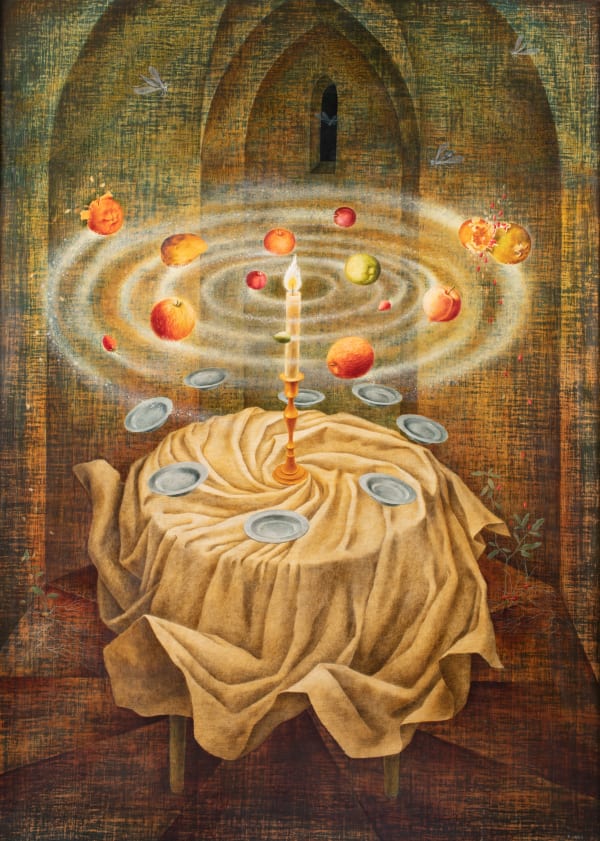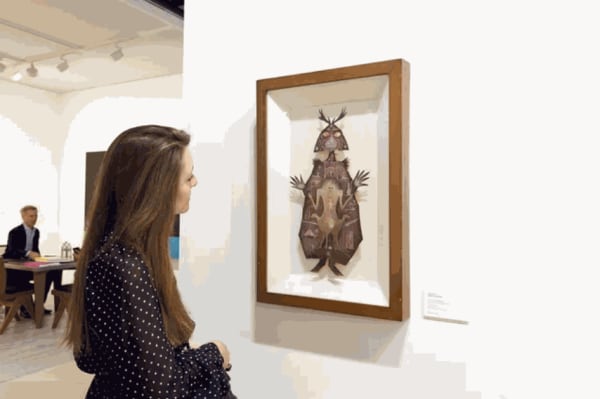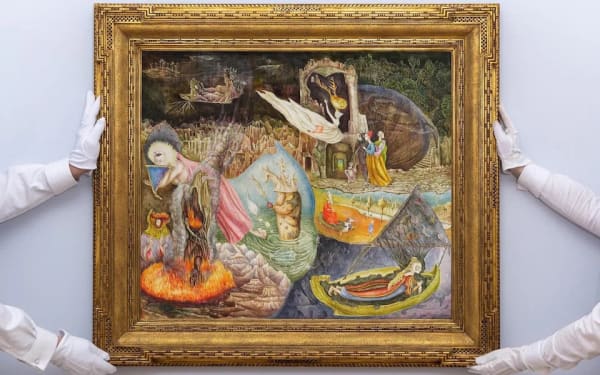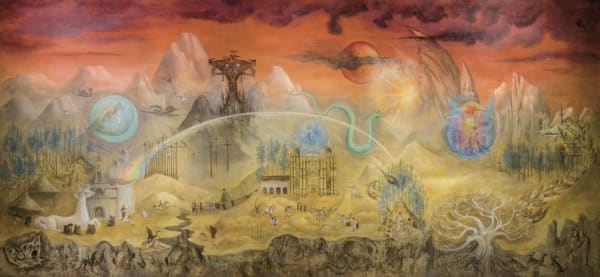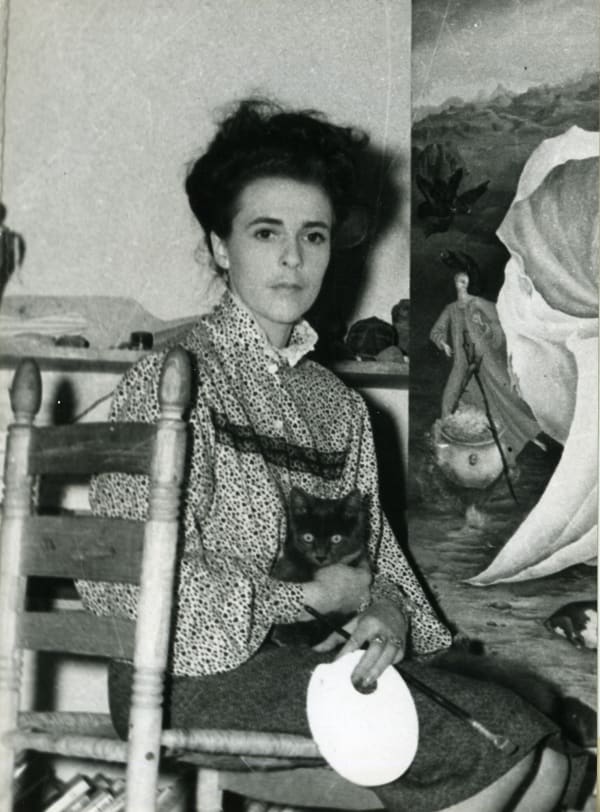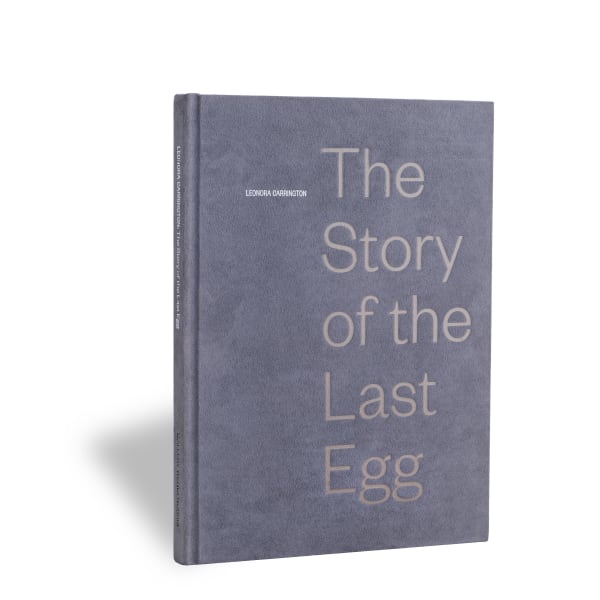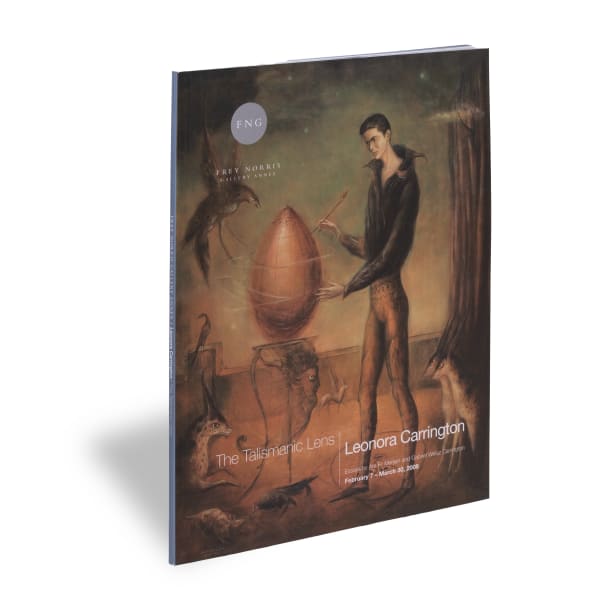Leonora Carrington was born in 1917 in Lancashire, England and passed away in 2011 at the age of 94 in Mexico City, Mexico. A leading artist of the 20th century, Carrington incorporated painting, drawing, sculpture, textiles, printmaking, and writing into a body of work produced throughout her nearly seven-decade career.
Raised in the English upper class, Carrington's early life was privileged, yet her personal freedom was restricted by the conventions of traditional gender roles. However, Carrington's childhood was imbued with magical stories of Celtic mythology and folklore, as told by her Irish mother, grandmother, and nanny. In these fantastic tales of humans, animals, and nature living harmoniously as joined forces against threats of injustice and violence, she found ideas which would profoundly influence the rest of her life.
In 1937, Carrington's mother gifted her a copy of Herbert Read's Surrealism, which served as her first introduction to the growing avant-garde movement. While studying at Amédée Ozenfant's academy, Carrington met Max Ernst, and they began a romantic relationship. Together they moved to Paris where Carrington was introduced to André Breton, Yves Tanguy, Leonor Fini, and the larger community of artists and intellectuals in the city. In 1938, she participated in the Exposition Internationale du Surréalisme in Paris and a Surrealism exhibition in Amsterdam, cementing her position in art history among the Surrealists despite personally disagreeing with the categorization as such. While she and the Surrealists shared a disdain for bourgeois values, Carrington was resolutely autonomous, never ascribing to common Surrealist motifs.
At the outbreak of World War II in 1939, the German-born Ernst was considered an enemy alien and arrested. Alone in France, Carrington's mental stability weakened. With friends she fled to Spain, but along the journey her psychological state continued to deteriorate, leading to her forced admission into a sanitarium in Santander. She would later recount this experience in her memoir Down Below (1943).
Carrington escaped Spain in 1941 and passed through New York before arriving in Mexico City in 1942. She found a home in Mexico with fellow European émigrés Remedios Varo, who became her close friend, and the Hungarian photographer Emerico "Chiki" Weisz, whom she married in 1946. Carrington continued to exhibit internationally. As she experienced marriage and motherhood, Carrington's work became steeped in archetypically feminine iconography, such as cooking motifs and domestic interior scenes. She recognized the remnants of an ancient magic still present in the acts of making food, having a family, and painting pictures. She saw the similarities between what she was doing at home and what alchemists attempted to do — both involved manipulating inanimate matter to harness its life-endowing properties. It was in this period that Carrington revisited the Renaissance practice of using tempera paint, made from pigment and egg yolk, to imbue her aesthetic vision and the physical substance of her paintings with life itself.
Her art was well-received in Mexico, and in 1963 Carrington received a government commission to create a mural for the National Museum of Anthropology in Mexico City, which she titled El mundo mágico de los mayas (The Magical World of the Maya). In the 1960s and 1970s, Carrington became a political activist, hosting student meetings at her home and co-founding the Mexican women's liberation movement in 1972. In the 1980s, the renowned mural was moved to the Regional Museum of Anthropology and History of Chiapas in Tuxtla Gutiérrez, and in 1986 Carrington's political involvement earned her the Lifetime Achievement Award at the United Nations Women's Caucus for Art convention in New York. In 2005, Leonora Carrington received Mexico's National Prize of Sciences and Arts.
Carrington's work has been acquired by museums worldwide, including The Museum of Modern Art, New York; San Francisco Museum of Modern Art; The Metropolitan Museum of Art, New York; The Tate, London, United Kingdom; National Museum of Women in the Arts, Washington, D.C.; Peggy Guggenheim Collection, Venice, Italy; National Galleries of Scotland, Edinburgh; and Museum Boijmans van Beuningen, Rotterdam, Netherlands; Harvard Art Museums/Fogg Museum (Cambridge, MA); Dallas Museum of Art (Dallas, TX); Museo de Arte Moderno (Mexico City, Mexico), among others.
Since Carrington's passing in 2011, her work has been the subject of the following solo museum exhibitions: Leonora Carrington: Revelation at the ARKEN Museum of Modern Art, Ishøj, Denmark and Fundación MAPFRE, Madrid, Spain (2022-2023); Leonora Carrington: Magical Tales at the Museo de Arte Moderno, Mexico City and the Museo de Arte Contemporáneo, Monterrey, Mexico (2018); Leonora Carrington at the Tate Liverpool, United Kingdom (2015); and The Celtic Surrealist at the Irish Museum of Modern Art, Dublin, Ireland (2014).
Carrington’s first solo museum exhibition in Italy opened at the Palazzo Reale in Milan in October 2025 before traveling to the Musée de Luxembourg in Paris.
Her work has also been featured in the exhibitions In Wonderland: The Surrealist Adventures of Women Artists in Mexico and the United States (2012) at the Los Angeles County Museum of Art, California; Fantastic Women: Surreal Worlds from Meret Oppenheim to Frida Kahlo at the Schirn Kunsthalle Frankfurt, Germany (2020) and the Louisiana Museum in Copenhagen, Denmark (2020); Surrealism Beyond Borders at The Metropolitan Museum of Art, New York (2021) and Tate Modern, London (2022); Surrealism and Magic: Enchanted Modernity at the Peggy Guggenheim Collection, Venice, Italy (2022) and Museum Barberini, Potsdam, Germany (2022); and the 59th Venice Biennale, The Milk of Dreams (2022), the title of which was taken from a book by Leonora Carrington; and Surréalisme, Centre Pompidou (2024) and Philadelphia Museum of Art (2025).
-
 Green Tea
Green Tea -
 Untitled
Untitled -
 La cuna (The Cradle)
La cuna (The Cradle) -
 The Kitchen Garden on the Eyot
The Kitchen Garden on the Eyot -
 Untitled
Untitled -
 Buen Rey Elk Horn
Buen Rey Elk Horn -
 Portrait of Madame Dupin
Portrait of Madame Dupin -
 Fina mosca
Fina mosca -
 Ulu's Pants
Ulu's Pants -
 And Then We Saw the Daughter of the Minotaur!
And Then We Saw the Daughter of the Minotaur! -
 Untitled
Untitled -
 Yaweah
Yaweah -
 Temblor
Temblor -
 Crookhey Hall
Crookhey Hall -
 Untitled
Untitled -
 Canultrafax
Canultrafax -
 Cerebro de Pedro
Cerebro de Pedro -
 Untitled
Untitled -
 The Fall of the House of Mink
The Fall of the House of Mink -
 Rueda de los caballos (preliminary drawing)
Rueda de los caballos (preliminary drawing) -
 More Frontiers of Space
More Frontiers of Space -
 Untitled, Santander, page from sketchbook
Untitled, Santander, page from sketchbook -
 Cumpleaños
Cumpleaños -
 Untitled (Three Figures)
Untitled (Three Figures) -
 For the Man Who Did It Last Time Will Never Do It Now
For the Man Who Did It Last Time Will Never Do It Now -
 Equinoxio
Equinoxio -
 La Jaca
La Jaca -
 A Map of the Human Animal
A Map of the Human Animal -
 La maja del Tarot
La maja del Tarot -
 The Bird Men of Burnley
The Bird Men of Burnley -
 Sanctuary for Furies
Sanctuary for Furies -
 The Last Fish
The Last Fish -
 Bird Bath II
Bird Bath II -
 The Lovers
The Lovers -
 Installation view, "Fantastic Women: Surreal Worlds from Meret Oppenheim to Frida Kahlo," Schirn Kunsthalle Frankfurt, Frankfurt am Main, Germany
Installation view, "Fantastic Women: Surreal Worlds from Meret Oppenheim to Frida Kahlo," Schirn Kunsthalle Frankfurt, Frankfurt am Main, Germany -
 Installation view, "Leonora Carrington," ARKEN Museum of Modern Art, Copenhagen, Denmark
Installation view, "Leonora Carrington," ARKEN Museum of Modern Art, Copenhagen, Denmark -
 Installation view, "Leonora Carrington’s Bestiary," Art Basel 2024, booth D10, Basel, Switzerland
Installation view, "Leonora Carrington’s Bestiary," Art Basel 2024, booth D10, Basel, Switzerland -
 Installation view, "Landscapes of the Mind," Frieze Masters 2024, booth F16, London, England
Installation view, "Landscapes of the Mind," Frieze Masters 2024, booth F16, London, England
-

Modern Milieu
August 5 - September 10, 2025Gallery Wendi Norris 436 Jackson Street, San Francisco Gallery Wendi Norris presents Modern Milieu , featuring works by Leonora Carrington, Leonor Fini, Wolfgang Paalen, Alice Rahon, and Dorothea Tanning. Coinciding...Read more -

Leonora Carrington | Mythopoesis
January 21 - March 15, 2025For its inaugural exhibition of 2025, Gallery Wendi Norris presents Leonora Carrington: Mythopoesis , its fifth Carrington exhibition and the first Carrington show in San Francisco in ten years. From...Read more -

Leonora Carrington | The Story of the Last Egg
May 23 - June 29, 2019GALLERY WENDI NORRIS OFFSITE EXHIBITION 926 Madison Avenue, New York, NY In the first New York solo exhibition in 22 years for the late artist, Gallery Wendi Norris presents '...Read more -

Threads of Memory
One Thousand Way of Saying Goodbye October 21 - November 15, 2017Gallery Wendi Norris’ final exhibition at 161 Jessie Street, Threads of Memory: One Thousand Ways of Saying Goodbye, presents a celebratory survey of the gallery’s program, including emblematic works by...Read more -

Leonora Carrington | The Celtic Surrealist
April 3 - May 31, 2014San Francisco - Gallery Wendi Norris presents Leonora Carrington : The Celtic Surrealist , a traveling subset of works from the critically acclaimed 2013 exhibition at the Irish Museum of...Read more -

Leonora Carrington: The Talismanic Lens
February 7 - March 30, 2008Frey Norris Gallery presents 'The Talismanic Lens,' the result of a five year endeavor of collecting, studying and getting to know Leonora Carrington, one of the last surviving Surrealist artists...Read more
-

FOG Design+Art 2026 | Booth 118
Leonora Carrington, Rohini Devasher, Maren Hassinger, Lisa Jo, Enrique Martínez Celaya, Leo Marz, Wolfgang Paalen, and Marie Wilson January 21 - 25, 2026For Gallery Wendi Norris’ inaugural presentation at FOG Design+Art, we will highlight the gallery’s international and multigenerational program through historically significant masterpieces and new works...Read more -

Art Basel Miami Beach 2025 | Booth G7
Enrique Martínez Celaya and Leonora Carrington December 3 - 7, 2025Gallery Wendi Norris is pleased to return to Art Basel Miami Beach 2025 with a presentation of paintings by Enrique Martínez Celaya , complemented by...Read more -

Frieze Masters 2025 | Booth F17
Leonora Carrington, Wolfgang Paalen, Alice Rahon, Remedios Varo, and Peter Young October 15 - 19, 2025Gallery Wendi Norris is pleased to return to Frieze Masters in London with a presentation exploring how Mexico’s artistic traditions, cultural heritage, and varied landscape...Read more -
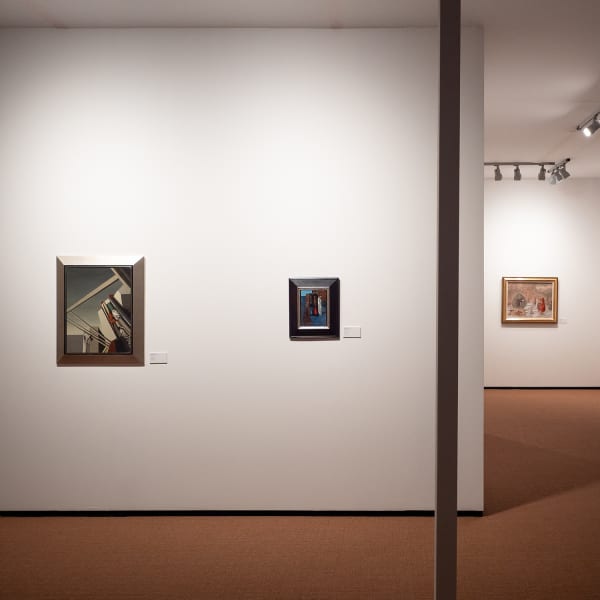
Frieze Masters 2024 | Booth F16
Leonora Carrington, Wolfgang Paalen, Marcel Jean, Bridget Tichenor, Alice Rahon, Dorothea Tanning, Remedios Varo, Kay Sage, and Leonor Fini October 9 - 13, 2024“The sincerity of the artist consists, not in copying the reflection of the world on his retina, but in testifying with sincerity to all his...Read more -
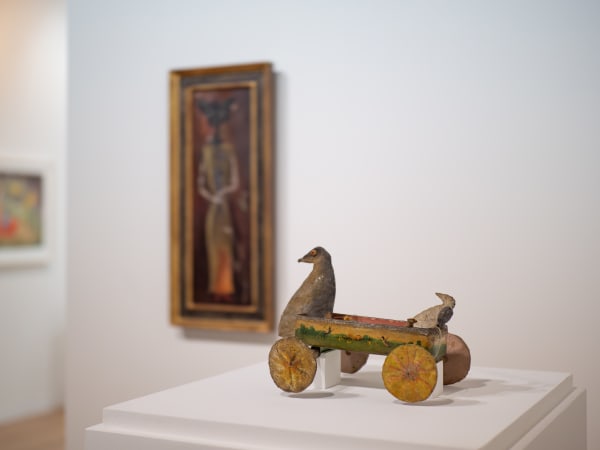
Art Basel 2024 | Booth D10
Leonora Carrington June 13 - 16, 2024'Once a dog barked at a mask I made; that was the most honourable comment I ever received.' (Leonora Carrington in 'Commentary,' 'Leonora Carrington: A...Read more -
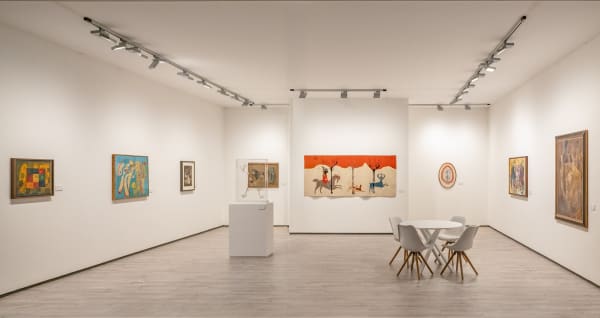
Frieze Masters 2023
Leonora Carrington, Remedios Varo, Alice Rahon, and Wolfgang Paalen October 11 - 15, 2023Between Here and There “Breton Péret Buñuel Leonora Remedios Paalen Alice Gerzso Frida Gironella César Moro convergence of insurgences … There is no outside nor...Read more -

Frieze Masters 2022
Eileen Agar, Leonora Carrington, Remedios Varo, Alice Rahon, Dorothea Tanning October 12 - 16, 2022Gallery Wendi Norris will present 'Phenomena,' a group exhibition featuring fresh-to-market modern works by gallery artists Eileen Agar, Leonora Carrington, Remedios Varo, Alice Rahon, and...Read more -
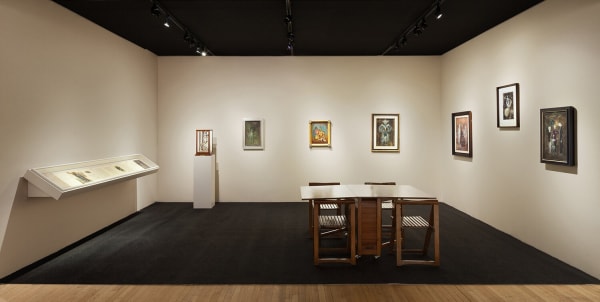
ADAA The Art Show | New York 2020
Leonora Carrington and Remedios Varo February 27 - March 1, 2020Gallery Wendi Norris is pleased to present rare works by Leonora Carrington and Remedios Varo this week at the ADAA The Art Show. Leonora Carrington...Read more -
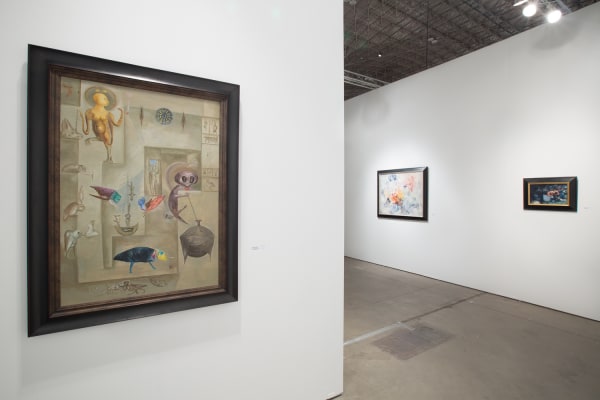
EXPO Chicago 2014
Val Britton, Leonora Carrington, Helen Rebekah Garber, Yamini Nayar, Dorothea Tanning September 18 - 21, 2014Read more
-

Wall Street Journal | The Best Work at Art Basel Miami Beach 2025
Enrique Martínez Celaya & Leonora Carrington December 4, 2025By Brian P. Kelly Carrington, long shunned by the mainstream, is having a moment, as is clear from her well-received exhibition in Milan and the...Read more -

Wall Street Journal | ‘Leonora Carrington’ Review: An Exhibit of Imagination in Milan
Leonora Carrington at the Palazzo Reale December 1, 2025By A.J. Goldmann Milan Leonora Carrington’s grandmother is making tortillas in Milan. Or rather, in one of Palazzo Reale’s dimly lighted galleries, “Grandmother Moorhead’s Aromatic...Read more -

The New York Times | In London, a California Gallery Shows Expat Mexican Surrealists
For two decades, Gallery Wendi Norris has broadened and complicated ideas about Surrealism. Now she is bringing major Mexican-influenced works to Frieze Masters. October 3, 2025By Will Higginbotham On a Friday morning in July, in the Jackson Square neighborhood of San Francisco, just a stone’s throw from the Transamerica Pyramid,...Read more -

ArtReview | The Other Leonora Carrington
Leonora Carrington: Mythopoesis March 5, 2025By Theodora Walsh The late surrealist painter and writer was known for her dreamlike paintings but a new exhibition brings her versatility between mediums to...Read more
-

The Brooklyn Rail | Leonora Carrington: Mythopoesis
Leonora Carrington: Mythopoesis March 1, 2025By Mark Van Proyen For several decades, the art world has witnessed a widespread resurgence of fantasy figuration, reaching a high point in the 2022...Read more -

Datebook | January 2025 has been a year, so I escaped to this S.F. gallery
Leonora Carrington: Mythopoesis February 7, 2025by Tony Bravo 7 February 2025 I could stare at Leonora Carrington’s art for hours and still discover new worlds and characters. And in times...Read more -

KQED | Who Needs AI Dreamscapes When We Have Leonora Carrington?
Leonora Carrington: Mythopoesis February 5, 2025by Brian Karl 5 February 2025 Where do dreams come from? Questions about their origin are worth asking on occasion, especially when a sampling of...Read more -

Cultured Magazine | In the Midst of FOG, Co-Chairs and Collectors Mario Russo and Jim Abrams Share Their Must-See Exhibitors and Shows
The San Francisco fair presents a perfect opportunity to get to know the city's "under-the-radar" art scene. January 24, 2025by Cristina Macaya 24 January 2025 Collectors Mario Russo and Jim Abrams have a clear take on San Francisco’s art scene: personal, unpretentious, and brimming...Read more
-

Marin Independent Journal | Where to see artworks in Marin
January 22, 2025by Daniel Bromfield 22 January 2025 Outside Marin Gallery Wendi Norris: 436 Jackson St., San Francisco; gallerywendinorris.com . Through March 15: “Mythopoesis,” multimedia works by...Read more -

Datebook | The best things to do at San Francisco Art Week
Leonora Carrington: Mythopoesis January 18, 2025by Tony Bravo 18 January 2025 Gallery Wendi Norris will present its fifth solo exhibition of the British-born surrealist Leonora Carrington with “Mythopoesis .” Norris’...Read more -

Artnet | As Leonora Carrington’s Market Soars, San Francisco Gallery Plans Major Show
Dealer Wendi Norris will present some 15 works that span 50 years—and many mediums. January 4, 2025by Eileen Kinsella 4 January 2025 Last year was a big one for the market of Surrealist master Leonora Carrington, whose colorful life and works...Read more -

Art Basel | Data, Surrealism, and a little magic: Gallerist Wendi Norris’ recipe for success
Credited with fostering the legacies of artists such as Leonora Carrington and Dorothea Tanning, she will soon showcase her vibrant program at Art Basel Miami Beach for the first time November 14, 2024By Tara Anne Dalbow 14 November, 2024 For San Francisco gallerist Wendi Norris , words matter. More so than ‘surrealist’ – the characteristic most often...Read more
-

Galerie | Discover Why Surrealism Is Having a Major Moment
A century later, Surrealism, especially its female practitioners, once again captivates the art world with its disorienting, allegorical style October 16, 2024by Ted Loos 16 October 2024 When Leonora Carrington ‘s fanciful and dramatic 1945 canvas Les Distractions de Dagobert sold for $28.5 million at Sotheby’s...Read more -

Artnet | An Expansive New Surrealism Show Celebrates 100 Years Of Artistic Revolution
Featuring more than 500 objects, the Centre Pompidou's "Surrealism" show explores the global reach and diversity of the artistic movement. October 4, 2024by Sofia Hallström 4 October 2024 Between the rise of artificial intelligence and the proliferation of “fake news,” living in the 21 st -century can...Read more -

Frieze | Celebrating 100 Years of Surrealism at Frieze
Discover the movement’s iconic artists and contemporary legacy at the London fairs, from Man Ray, Dora Maar and Leonora Carrington, to Carol Bove and Leiko Ikemura October 3, 2024By Livia Russell 3 October, 2024 '...Leonora Carrington ‘didn’t have time to be anyone’s muse’. Having left London for Paris, with the arrival of World...Read more -

Twelve Museums Acquire Works by Gallery Wendi Norris Artists
July 9, 2024June 9, 2024 Please join Gallery Wendi Norris in congratulating the Art Institute of Chicago, the Asian Art Museum, the Brooklyn Museum, the Cincinnati Art...Read more
-

The Art Newspaper | San Francisco gallery capitalises on Leonora Carrington’s auction success
Fairgoers flock to stand dedicated to the Surrealist artist after Sotheby’s sale of painting last month for $28.5m June 13, 2024Carlie Porterfield 12 June 2024 A solo stand dedicated to the Surrealist artist Leonora Carrington (1917-2011) has been a fan favourite among Art Basel visitors...Read more -

ARTnews | A Bay Area Dealer Who Rewrote the History of Surrealism Makes Her Art Basel Debut
June 11, 2024By Alex Greenberger June 11, 2024 These days, it is hard to imagine a time when everyone wasn’t talking about Leonora Carrington’s art. In 2022,...Read more -

Hyperallergic | Leonora Carrington Masterpiece Sells for $28.5M, Shattering Records
The Surrealist work, acquired by Argentinian museum founder Eduardo F. Costantini, makes Carrington the most valuable UK-born woman artist on the public market. May 16, 2024Valentina Di Liscia May 16, 2024 Eduardo F. Costantini, the Argentinian businessman, real-estate developer, and founder of the Museo de Arte Latinoamericano de Buenos Aires...Read more -

The Telegraph | How Leonora Carrington Entered Art's Super League
The surrealist who scoffed at her own success is now Britain’s most successful female artist in terms of sales May 7, 2024By Colin Gleadell May 7, 2024 A British artist who was expelled from several schools, rejected by her family, hospitalised for psychosis, and believed her...Read more
-

Ocula | Frieze Masters 2023 Artwork Highlights
October 18, 2023Leonora Carrington , Cerebro de Pedro (1967) at Gallery Wendi Norris, San Francisco Made for the artist Pedro Friedeberg, this watercolour on paper by the...Read more -

Artforum | Gods and Monsters: Susan L. Aberth on “Leonora Carrington: Revelación”
May 1, 2023Susan L. Aberth May 2023 AS LEONARA CARRINGTON'S STAR continues to ascend, propelled by an explosion of exhibitions, publications, theatrical productions, and documentary films-last year's...Read more -

W Magazine | Why Leonora Carrington’s Work Feels So of the Moment
The Surrealist's dreamlike paintings and idiosyncratic life story are resonating with a new generation. February 4, 2022Kate Dwyer February 4, 2022 On Wednesday, the Venice Biennale announced the lineup for its 2022 edition, a 'transhistoric exhibition' emphasizing female and gendernonconforming artists...Read more -

Four Gallery Wendi Norris Artists Selected for Venice Biennale 2022
February 3, 2022Gallery Wendi Norris celebrates the invitation of four of our artists to The Milk of Dreams , the 59th International Art Exhibition of La Biennale...Read more
-

ARTnews | Paying Tribute to Leonora Carrington, 2022 Venice Biennale Takes the Title ‘The Milk of Dreams’
June 9, 2021Maximilíano Durón June 9, 2021 The 59th edition of the Venice Biennale will be titled 'The Milk of Dreams,' the exhibition's artistic director, Cecilia Alemani...Read more -

Art in America | Synthetic Surrealism
April 7, 2021By Lucy Ives April 7, 2021 In 1949, seven years after fleeing a warring Europe for Mexico City, the artist and writer Leonora Carrington (1917-2011)...Read more -

Art in America | How Leonora Carrington’s Surrealist Art Imaginatively Reclaimed Female Perspectives
April 7, 2021By Tessa Solomon April 7, 2021 As artist Leonora Carrington told it, shortly after she became friends with members of the Surrealist movement, Joan Miró...Read more -

The Nation | Leonora Carrington’s Irreverent Dreamscapes
The surrealist painter’s only novel, The Hearing Trumpet, is a wily, epicurean, and hilariously scattershot exploration of nature, religion, myth, and more. April 1, 2021Zachary Fine April 1, 2021 The life of the Surrealist painter and writer Leonora Carrington has, through time, shrunken into a myth. She was born...Read more
-

Hyperallergic | A Revelatory Tarot Deck by Leonora Carrington
Resurfacing a little known part of the artist's oeuvre, a new text from Fulgur Press demonstrates that occultism was thoroughly knit into the fabric of Carrington's life. March 3, 2021Cassie Packard March 3, 2021 Until recently, even leading scholars weren't aware that the British-born Mexican Surrealist Leonora Carrington had created her own tarot deck....Read more -

The New Yorker | How Leonora Carrington Feminized Surrealism
Each time the work of the British-Mexican artist and writer is reborn, it seems more prescient. December 21, 2020By Merve Emre December 21, 2020 When asked to describe the circumstances of her birth, the Surrealist painter and writer Leonora Carrington liked to tell...Read more -

The Tarot of Leonora Carrington
December 10, 2020By Susan Aberth and Tere Arcq Introduction by Gabriel Weisz Carrington Published by Fulgur Press The British-born artist Leonora Carrington (1917–2011) is one of the...Read more -

Artnet | Sotheby’s Middling Impressionist and Modern Sale Nets $62.8 Million Thanks to a Major Boost From Latin American Treasures
June 30, 2020Eileen Kinsella June 30, 2020 Sotheby's started off the lengthy auction evening on a strong note, but bidding for Impressionist and Modern art was more...Read more
-

ARTnews | Sotheby’s Global Hybrid Online Evening Sale Soars to $363.2 M.
June 30, 2020Angelica Villa June 30, 2020 The art market reopened last night with a resounding bang as Sotheby’s sold $363.2 million in modern and contemporary art...Read more -

Literature and Arts of the Americas | Leonora Carrington: The Story of the Last Egg
Gallery Wendi Norris - Offsite Exhibition New York City, May 23rd, 2019 to June 2019 June 17, 2020Margaret Carson June 17, 2020 Review: Literature and Arts of the Americas , 53:2, 145-148 , (2020) Margaret Carson's translations include Remedios Varo's Letters, Dreams...Read more -

Artsy | How These 7 Women Are Making the Art World More Diverse
March 9, 2020Anna Louie Sussman March 9, 2020 Women have played key patronage roles in the history of art—from the Egyptian Queen Hatshepsut, through Renaissance patrons such...Read more -

AnOther Magazine | Top Ten Surrealists: From Dorothea Tanning to Man Ray
March 5, 2020Daisy Woodward March 5, 2020 Surrealism - that seminal artistic and literary movement led by French poet André Breton - has continued to inspire creative...Read more



